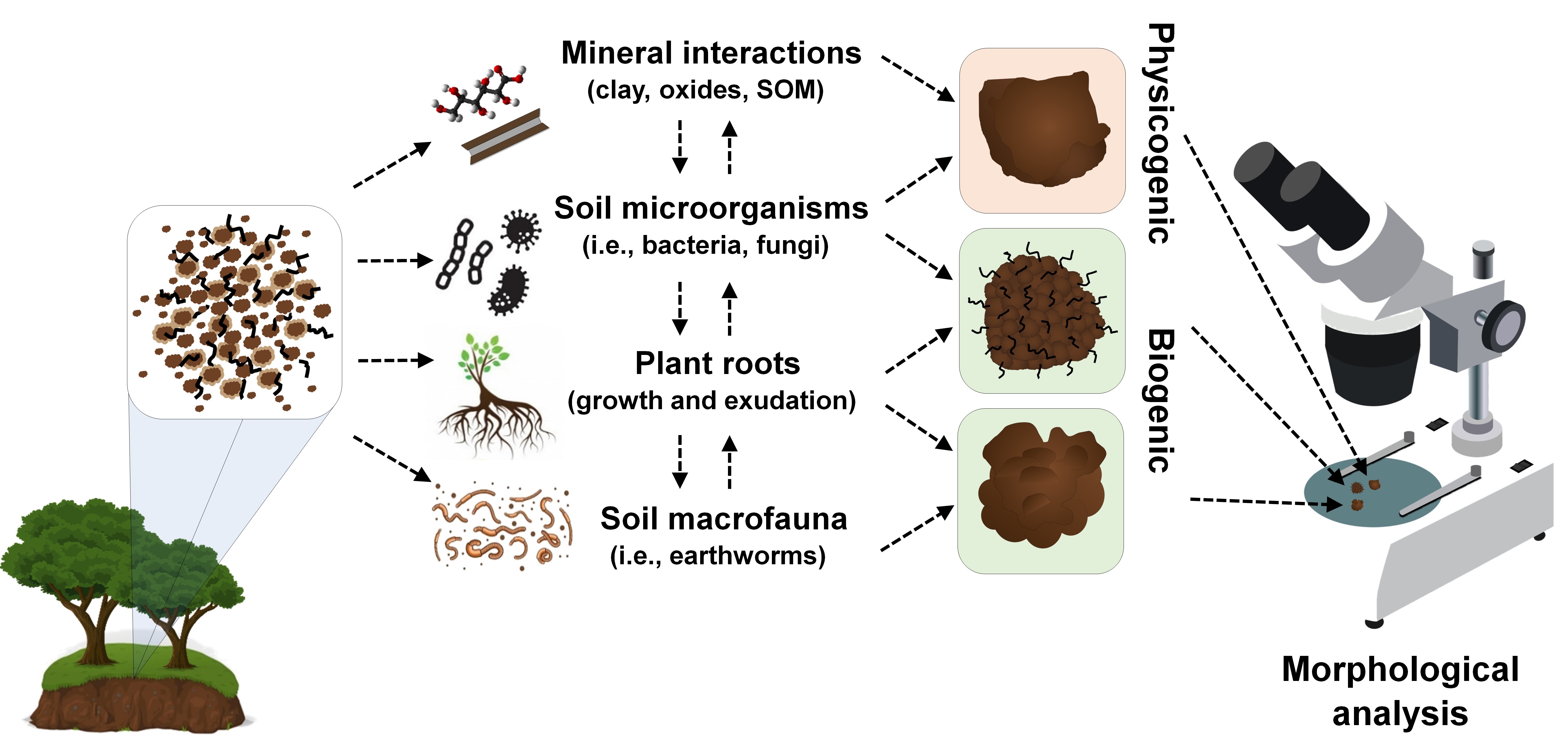Biogenic and physicogenic aggregates: formation pathways, assessment techniques, and influence on soil properties
24/Nov/2021
ABSTRACT: The soil particles can be gathered through physical and/or chemical processes in association with the biological activity, leading to the formation of aggregates. Soil aggregates has several functions in the soil, increasing macroporosity and water circulation – consequently reducing soil erosion and mechanical resistance to root growth, contributing to greater fixation of plants to the soil and absorption of water and nutrients, and protection of intra-aggregate organic matter. The aggregates were initially classified morphologically and in terms of their […]
Influence of ZnO Nanoparticles and a Non-Nano ZnO on Survival and Reproduction of Earthworm and Springtail in Tropical Natural Soil
13/May/2019
ABSTRACT: In recent years, various studies and development using nanoparticles (NPs) have been carried out in the most diverse areas of knowledge. Although nanomaterials are widely employed by many sectors and some may have a fertilizing potential, little is known about their effects on the environment. This study aimed to evaluate the effect of applying, in tropical natural soil, different contents of nanoparticles of zinc oxide (NPs-ZnO) and non-nano zinc oxide (ZnO) on soil pH and on the survival and […]
Morphological Diversity of Springtails in Land Use Systems
05/Sep/2018
ABSTRACT: Springtails (Collembola) are soil organisms with wide morphological diversity and are sensitive to alterations in the soil, regardless of whether they are human-caused or not. The aim of this study was to evaluate the influence of land use on the morphological diversity of springtails and verify their relationships with soil physical, chemical, and microbiological properties. Samples were collected in the eastern region of Santa Catarina, in three municipalities: Joinville, Blumenau, and Timbó. They included the following land use systems […]
Collembola Community Structure as a Tool to Assess Land Use Effects on Soil Quality
09/Dec/2016
ABSTRACT: Collembolan species are differently affected by soil tillage (conventional, minimum tillage, and no-tillage) and are known to modify plant growth. This study relies on the relationships between Collembola community structures and land use systems as a proxy for characterizing changes in soil quality. Thus, Collembola community structure (eco-morphological groups – edaphic, hemiedaphic and epigeic, and morphotypes) were examined in a no-tillage system and crop-livestock integration system to evaluate the discriminative power of the Collembola community structure and to determine […]
Litter Decomposition of Two Pioneer Tree Species and Associated Soil Fauna in Areas Reclaimed after Surface Coal Mining in Southern Brazil
17/Oct/2016
ABSTRACT Decomposition of leaf litter from pioneer tree species and development of associated soil meso- and macrofauna are fundamental for rehabilitation processes in reclaimed coal mining areas. The aim of our study was to evaluate decomposition of Schinus terebinthifolius and Senna multijuga to answer three basic questions: (i) What type of leaf litter degrades faster in reclaimed coal mining areas? (ii) Is leaf decomposition correlated with the stage of regeneration and exposure time? and (iii) Does the type of leaf […]
Soil Macrofauna and Physical and Chemical Properties under Soil Management Systems in the Santa Catarina Highlands, Brazil
01/Dec/2015
ABSTRACT Soil use can change processes such as soil organic matter decomposition, nutrient cycling, and particle aggregation, which, in turn, influence the occurrence of macrofauna. The objective of this study was to relate land use systems to their effects on the distribution of soil macrofauna groups, as well as their relation to soil physical and chemical properties. The land use systems evaluated were native forest, an Eucalyptus plantation, pasture, a crop-livestock integration area, and a no-tillage crop area. Samples were […]
Relationship among soil attributes and ant activity in restinga soils
01/Feb/2010
In restinga soils with sand-quartzous constitution the influence of the organic fraction and biological activity on soil key functions is increased, e.g., the capacity of recycling and storing nutrients. The analysis of soil attributes and edaphic fauna at sites under different vegetation cover types is important to understand the behavior of these environments. In this study, chemical, physical and microbiological soil attributes of restinga sites and their relationships with ant populations under different vegetation types in the state of Sergipe […]
Springtails (Hexapoda: Collembola) as soil quality bioindicators in areas with Araucaria angustifolia
01/Dec/2008
There is no information about the diversity of springtails associated with Araucaria angustifolia (Bert.) O. Kuntze forests in Brazil. This study was carried out to evaluate the potential of springtail family diversity as a soil quality indicator and to separate different Araucaria areas, using soil chemical and microbiological attributes as explanatory variables. The study was conducted in four areas of: 1. native forest with predominance of Araucaria (NF); 2. Araucaria reforestation (R); 3. Araucaria reforestation burnt by an accidental fire […]
Soil microbial community and mesofauna under dry forest vegetation in the semi-arid region of Paraíba, Brazil
01/Feb/2008
The biological soil activity is responsible for several physical and chemical transformations of deposited organic residues, therefore maintaining the environmental sustainability. The aim of this study was to evaluate the distribution of the soil microbial community and mesofauna in a dry forest (Caatinga) in the semi-arid region of Paraíba, northeastern Brazil. To determine the microorganism population soil samples from the 0-15 cm soil layer were evaluated. Total counts of fungi and bacteria were evaluated in specific culture media. The Berleusse-Tüllgren modified […]
Characterization of soil fauna in different vegetation covers in the northern Fluminense region (RJ)
01/Jul/2005
The soil-litter system is a natural habitat for a great variety of organisms that differ in size and metabolism and are responsible for numerous functions. The study of groups of organism in the soil-litter system allows not only to make inferences on the functionality of these organisms, but also is a simple indication of the ecological complexity in these communities. Our study aimed at characterizing the distribution of groups of organism in soil and litter compartments in two seasons of […]

